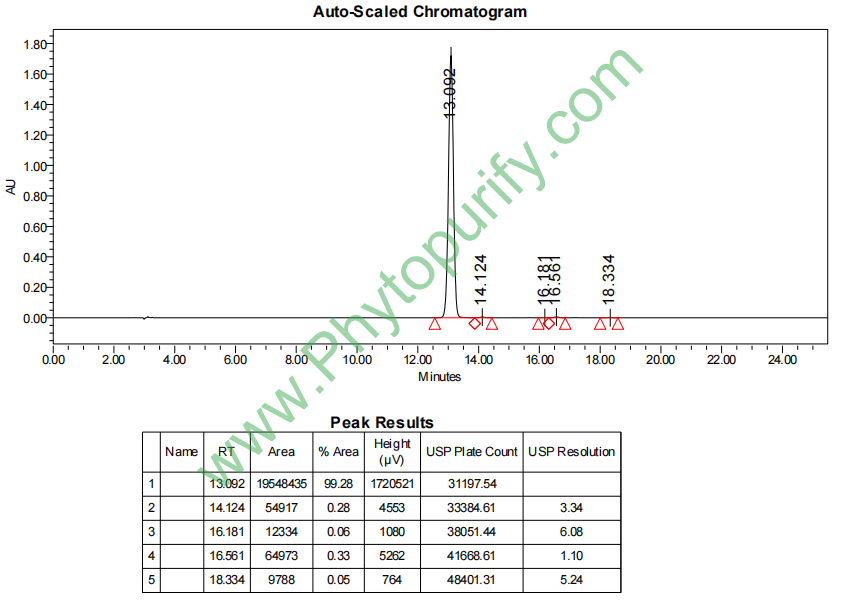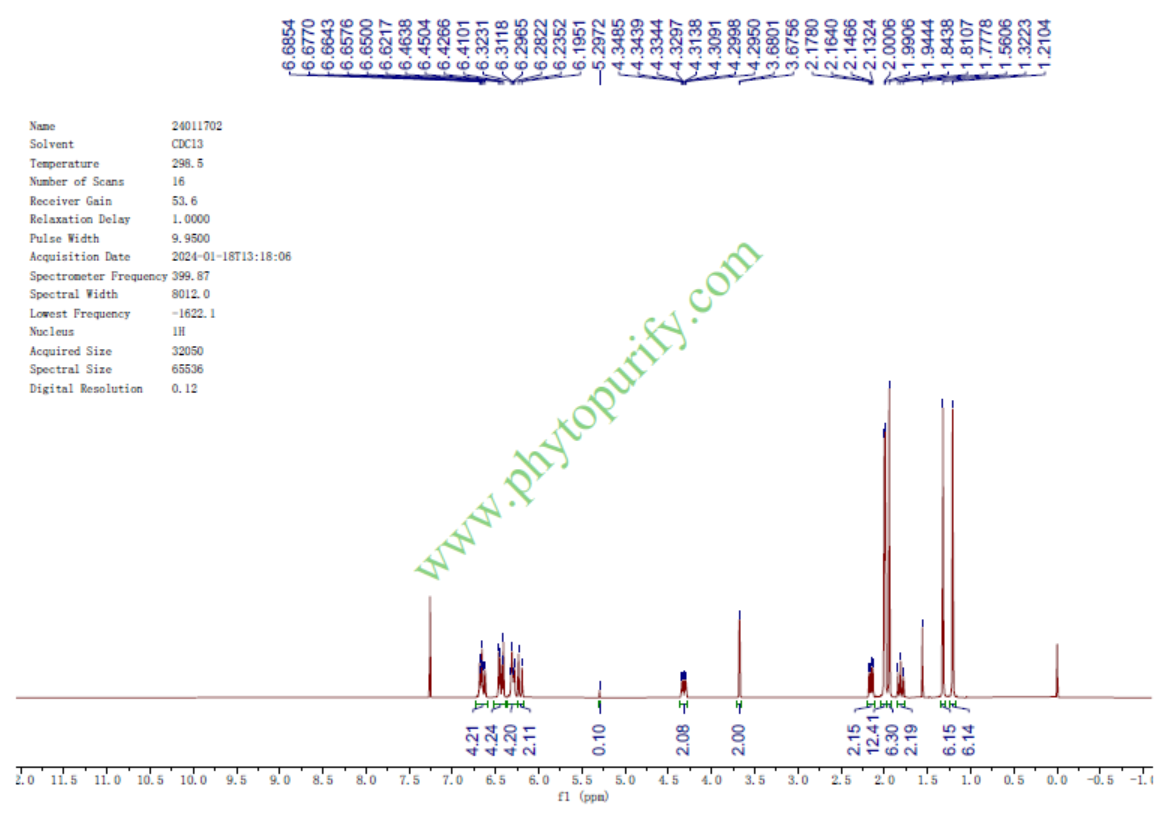
AstaxanthinCAS No.:472-61-7 |
||||||||||
 |
|
|
||||||||

| Catalogue No.: | BP1506 |
| Formula: | C40H52O4 |
| Mol Weight: | 596.852 |
Product name: Astaxanthin
Synonym name:
Catalogue No.: BP1506
Cas No.: 472-61-7
Formula: C40H52O4
Mol Weight: 596.852
Botanical Source: Haematococcus pluvialis
Physical Description: Red powder
Type of Compound: Miscellaneous
Purity: 95%~99%
Analysis Method: HPLC-DAD or/and HPLC-ELSD
Identification Method: Mass, NMR
Packing: Brown vial or HDPE plastic bottle
The product could be supplied from milligrams to grams. Inquire for bulk scale.
We provide solution to improve the water-solubility of compounds, thereby facilitating the variety of activity tests and clinic uses.
For Reference Standard and R&D, Not for Human Use Directly.
Description:
Astaxanthin is a strong antioxidant which shows neuroprotective property and can reduce the markers of inflammation, it can reduce matrix metalloproteinase expression in human chondrocytes, it may be beneficial in the treatment of osteoarthritis.Astaxanthin has protective effect on fetal alcohol spectrum disorder, and suggests that oxidative stress and TLR4 signaling associated inflammatory reaction are involved in this process. Astaxanthin administration can reduce renal calcium oxalate crystal deposition possibly by modulating the renal renin-angiotensin system (RAS), which reduces the expression of OPN and TGF-β1 levels.
References:
Int Immunopharmacol. 2014 Mar;19(1):174-7.
Astaxanthin reduces matrix metalloproteinase expression in human chondrocytes.
Astaxanthin is a red carotenoid pigment which exerts multiple biological activities. However, little is known about the effects of Astaxanthin on matrix metalloproteinases (MMPs) in OA.
METHODS AND RESULTS:
The present study investigated the effects of Astaxanthin on MMPs in human chondrocytes. Human chondrocytes were pretreated with Astaxanthin at 1, 10 or 50μM, then, cells were stimulated with IL-1β (10ng/ml) for 24h. MMP-1, MMP-3 and MMP-13 were observed. We found that Astaxanthin reduced the expression of MMP-1, MMP-3 and MMP-13 as well as the phosphorylation of two mitogen-activated protein kinases (MAPK) (p38 and ERK1/2) in IL-1β-stimulated chondrocytes. Astaxanthin also blocked the IκB-α degradation.
CONCLUSIONS:
These results suggest that Astaxanthin may be beneficial in the treatment of OA.
Metab Brain Dis. 2015 Jun 27.
The antioxidant effect of astaxanthin is higher in young mice than aged: a region specific study on brain.
Astaxanthin is a potential antioxidant which shows neuroprotective property. We aimed to investigate the age-dependent and region-specific antioxidant effects of Astaxanthin in mice brain.
METHODS AND RESULTS:
Animals were divided into 4 groups; treatment young (3 months, n = 6) (AY), treatment old (16 months, n = 6) (AO), placebo young (3 months, n = 6) (PY) and placebo old (16 months, n = 6) (PO) groups. Treatment group was given Astaxanthin (2 mg/kg/day, body weight), and placebo group was given 100 μl of 0.9% normal saline orally to the healthy Swiss albino mice for 4 weeks. The level of non-enzymatic oxidative markers namely malondialdehyde (MDA); nitric oxide (NO); advanced protein oxidation product (APOP); glutathione (GSH) and the activity of enzymatic antioxidants i.e.; catalase (CAT) and superoxide dismutase (SOD) were determined from the isolated brain regions. Treatment with Astaxanthin significantly (p < 0.05) reduces the level of MDA, APOP, NO in the cortex, striatum, hypothalamus, hippocampus and cerebellum in both age groups. Astaxanthin markedly (p < 0.05) enhances the activity of CAT and SOD enzymes while improves the level of GSH in the brain. Overall, improvement of oxidative markers was significantly greater in the young group than the aged animal.
CONCLUSIONS:
In conclusion, we report that the activity of Astaxanthin is age-dependent, higher in young in compared to the aged brain.
Rev Biol Trop. 2014 Dec;62(4):1331-41.
The effect of astaxanthin on resistance of juvenile prawns Macrobrachium nipponense (Decapoda: Palaemonidae) to physical and chemical stress.
In recent years, the use of new scientific techniques has effectively improved aquaculture production processes. Astaxanthin has various properties in aquaculture and its antioxidant benefits have been closely related to stress resistance; besides, it is an essential factor for growth in many crustaceans and fish. The objective of this study was to evaluate the resistance of prawn (Macrobrachium nipponense) fed diets containing different amounts of Astaxanthin (AX) to the shock and stress of different physicochemical environments.
METHODS AND RESULTS:
A 70-day trial was conducted to evaluate the effect of supplementation of a source of Astaxanthin (Carophyll Pink, 10% Astaxanthin, w/w, Hoffman-La Roche, Switzerland) at various levels in the diet of M. nipponense juveniles. Four dry diets were prepared: AX0 without Astaxanthin, AX50 with 50 mg/kg, AX100 with 100 mg/kg, and AX150 with 150 mg/kg Astaxanthin. The feeding trial was conducted in a recirculation water system consisting of 12 fiberglass tanks (1000L) used for holding prawns. Three replicate aquaria were initially stocked with 36 org/m2 per tank. During the trial, prawns were maintained on a 12:12-h light:dark photoperiod with an ordinary incandescent lamp, and the water quality parameters were maintained as follows: water temperature, 25-26°C; salinity, 1 g/L; pH, 8.5-8.8; dissolved oxygen, 6.0-6.5 mg/L; and ammonia-nitrogen, 0.05 mg/L. Incorporation of AX, production output, and physiological condition were recorded after 10 weeks of feeding. At the end of the growing period, the prawns were exposed to thermal shock (0°C), ammonia (0.75 mg/L), and reduced oxygen (0.5 mg/L). The time to lethargy and the time to complete death of the prawns were recorded. The results showed that control prawns had the shortest time to lethargy and death compared with prawns subjected to the other treatments. The results of this study have shown that the amount of muscle tissue and gill carotenoids in prawn fed with an AX150 diet showed greater reduction than those exposed to other treatments. It is possible that higher levels of Astaxanthin in the body under oxygen reduction stress can be beneficial for prawns.
CONCLUSIONS:
These results suggest that male prawns showed lethargy earlier than females, and the percentage of carotenoid reduction in muscle and gill tissues was higher in males.
HPLC of Astaxanthin

HNMR of Astaxanthin
